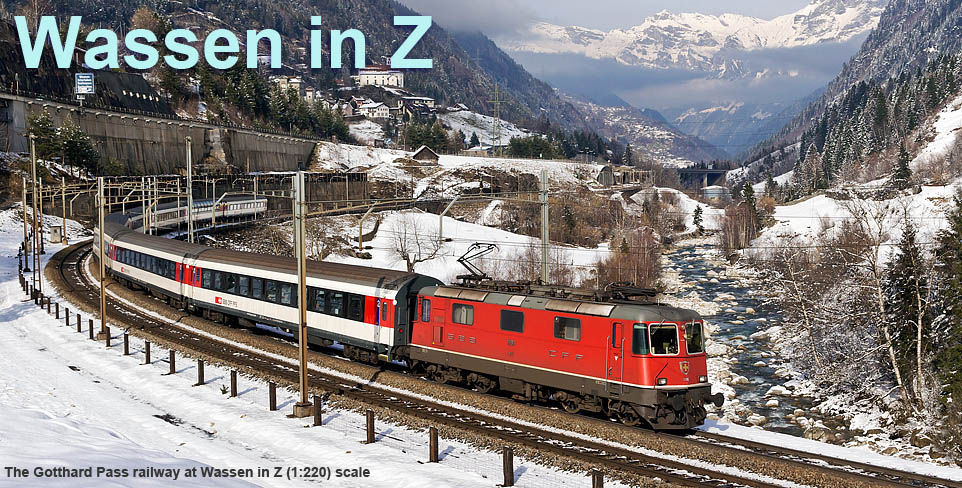The quintessential loco lashup on the Gotthard over the past few decades would have to be the so-called 'Re 10/10' pairing of an Re 4/4 and an Re 6/6.
So without a doubt, I need an Re 6/6 for Wassen - no model of an SBB Swiss railway in recent years would be complete without them....
While Marklin has produced Z scale Re 4/4s since 2012, the only Re 6/6s that have been produced in Z - that I'm aware of - were a very, very limited run of fairly expensive brass models from SZL (Swiss Z Line - the same folks as AZL who make the American stuff) several years back. These 6/6s seem to be an excellent model from what I have seen online, but as rare as hen's teeth and equally pricey.
A second option is a Shapeways shell, and perhaps I should have had a crack at that, but who doesn't enjoy a good modeling challenge!
So, I plumped for the third option, deciding it might be economical to convert a Marklin Ae 6/6 into an Re 6/6 if I could pick one up on the cheap.
The Ae 6/6 has a Co-Co wheel arrangement (instead of the Re's Bo-Bo-Bo) and is a little shorter in length and roof height, but it has the same general look, with a similar nose and four windows along the side. A year or more ago I purchased a red 'for spare parts' Ae 6/6 off eBay which was missing some bits, but had an intact body shell. Due to some misplacement by my parcel forwarding service (my old neighbours) it arrived a few days ago.
As I didn't have my phone with me when I started attacking this like a bull in a China Shop the day it arrived, let me present my initial findings via a borrowed picture (the model I purchased is actually red (fortunately) and missing pantographs among a few other bits):
As you can see, the overall look of the body is similar to the Re 6/6. The Re has single arm pantographs, but that's fine as my model didn't come with them anyway. And as I've mentioned - the wheel arrangement differs, but we'll tackle that later. My red one has rectangular buffers, which is actually correct for red Re 6/6s
So the immediate tasks to be tackled on the shell :
- The roof (hmmmm, more on this below... )
- Remove the bogie springing (molded onto the shell) - this was a one minute job.
- Carve off the front panel in front of the driver at each end (ditto). Well, actually I removed the edge closest to the side as this will be visible and left the inboard edge - this loco is always going to run behind a 4/4.
- Fill in those grilles - quick and easy enough with some Squadron Putty.
- Reshape the 'corner' windows.
- A bit of painting to cover all this mess up.
Voila:
At this stage I was feeling
pretty pleased with myself.
Until it was placed next to the Marklin Re 4/4...
I guess this Ae is quite an old model, probably with a chassis recycled from something else, and perhaps back then, being in scale wasn't so important.
Despite the 'real' Ae being shorter than the Re, this model is Re length. That's actually fine by me!
But it is a bit taller than it should be (worryingly so, as I still have to lift the roofline) and dealbreakingly, the model Ae 6/6 is almost 4mm wider than the model Re 4/4, and all these things should be within a hair. I think that even in Z scale, and even with visitors being vigorously discouraged from looking too closely, this big puppy would look far too wide rolling around behind a skinny little Re 4/4.
So the decision on what to do with the roof was solved for me: the roof would come off, the body split into two halves, and shrunk under a new roof of the correct width. The razor saw was duly engaged.
As an aside, this is the paint I'm using, which is a Vellajo Game Colour red. And a lucky guess, as it was purchased two years ago and is almost a perfect match for the red on the Ae 6/6 (less so for Marklin's darker and less-orangy 4/4 - they must have decided to change colour over the years). The filled-in grilles need another coat or two. Note that I've left the coat of arms in place. All Ae and Re locos were 'named' and carry canton or town coat of arms. I'll do something to the 'Altdorf' that came on this one in due course.
The genesis of a new plasticard roof at the correct width:
The new roof was shaped using knife, fine sandpaper, trial and error, and then some details added:
I mixed some silver and black to darken it a little for the main roof paint. The 4/4's roof should also be a silvey shade instead of Marklin's dark gray, but that will be dealt with in the future.
The distinctive Re 6/6 roof-edge grilles were made up in Photoshop, printed out on a laser printer and glued on top of the painted roof with PVA white glue. Some leftover bits were added to the top of the roof boxes per the prototype. Once these are all set I'll fill those white bits on the edges with paint and dark-wash the grilles.







